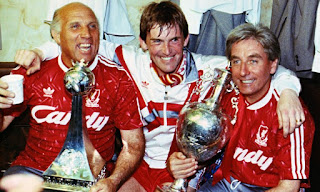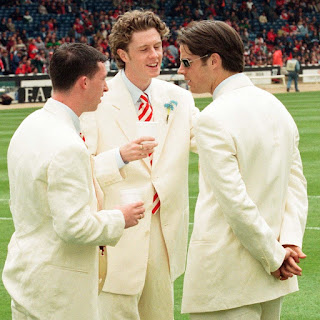'Ballina/Boher Parish, Our History and Traditions' (2000) by Kevin M. Griffin (my primary school headmaster) and his son Kevin A. Griffin. The cover artwork is by another son and my former classmate, Enda Griffin.
This blog has been brewing
away in my mind for a while now and I have my sister Anna to thank for prompting
me to finally finish and post it. Anna sent me on a link in recent days
relating to Dr. Pat O’Callaghan from Cork, a medical doctor and Olympian who
won gold in the hammer throw at the Olympics of 1928 and 1932:
https://www.corkbeo.ie/news/history/tg4-show-story-cork-man-19474753
And the story of Dr. Pat O’Callaghan
and Anna’s timely reminder about my brewing project got me thinking of another
athletic hero even closer to home.
'For the sake of the little village...'
Over the last few months I
have written about a range of sporting topics and heroes, from Olympic
basketball (see link: https://sportyman2020.blogspot.com/2020/10/cold-war-basketball.html) to the history of hurling (see link: https://sportyman2020.blogspot.com/2020/03/tipperary-and-kilkenny-curses-hurling.html ), from Eliud Kipchoge (see
link: https://sportyman2020.blogspot.com/2020/11/kipchoge.html) to Emil Zatopek (see link: https://sportyman2020.blogspot.com/2020/03/emil-zatopek-and-pandemic-running.html), along with my series of blogs on the history
of Liverpool Football Club.
As for my own recent sporting
exploits, I’ve been dealing with a running related injury for the past six
months. I’m conscious that listening to runners talking about their running is
tedious at best, but listening to runners talking about their injuries is
almost unbearable. Therefore, I won’t dwell on the detail, except to say that
the injury has forced me off my feet and on to my bike in recent months.
And while cycling lacks the
euphoriant endorphin surges of running, an upside is that this activity has led
to an expansion of the range and variety of my main exercise loops around the
Ballina and Killaloe area. The more relaxed nature of cycling has also helped
me reflect more on local topography and history, not least the sporting
history.
My map-art attempt at capturing my main running routes around Ballina and Killaloe
More map-art: my enforced cycling has now expanded my exercise territory to include much of northern Tipperary and even a loop around lovely Lough Derg, to the northwest in the above image
Coinciding with these
changes in my exercise routines and rituals, I was alerted to the story of a local
sporting hero, a man whose exploits in the early years of the 20th
century rival those of Kipchoge, Zatopek and even Kenny Dalglish himself. Many thanks to Seán
Ō Maoláin, my friend and fellow enthusiast for all things sporty, who was the first
person to tell me the story of this local sporting hero. Seán also gave me some
leads and I did some investigation. Next up I have to thank John Sage and David
O’Byrnes, who gave further background on the local hero, along with precise
directions to his old homestead.
So I headed off on my bike
one Saturday morning last autumn and found the homestead of Matt McGrath,
an Olympic hero who was born and reared just a few miles from my own home.
The old homestead of Matt McGrath, in the townland of Curraghmore, Ballina. Thanks to John Sage and David O'Byrnes for their help in directing me to the house and for background information on Matt McGrath. And thanks to Seán Ō Maoláin for first telling me the story.
The
story of Matt McGrath
Matt McGrath was born in the
townland of Curraghmore, in the parish of Ballina & Boher, Co. Tipperary in
1876. He emigrated to the United States in his twenties. The 1901 census record
shows that his father Timothy was then aged 49 and his mother Anne was 46 and there remained five younger siblings still at home.
Like so many other Irish of
the time, he joined up with the New York Police Department and reached the rank
of Police Inspector. During the course of an exemplary career, he was awarded
the Medal of Valor on two occasions.
Matt McGrath (1876-1941), Police Inspector in the NYPD and multiple Olympic medal winner
Matt was familiar with the
sport of hammer throwing and may well have been quite accomplished in the skills before leaving for America. It was likely this interest that drove him to join
the Irish American Athletic Club and the New York Athletic Club. Although a
relatively late starter in competition, he excelled and won countless local New
York and national competitions.
McGrath in action
But national success was not
enough for the big man from Curraghmore and he went on to make his mark on the
international stage by representing the United States in the hammer throwing
competitions at the Olympic Games of 1908, 1912, 1920 and 1924. Unfortunately,
pre-independence Ireland did not at the time have its own Olympic team.
I have covered the 1908
Olympic marathon in an earlier blog (see link: https://sportyman2020.blogspot.com/2020/04/the-first-marathon-as-we-now-know-it.html). That marathon was won by
Johnny Hayes, whose parents had come from Nenagh, just a few miles from the
birthplace of Matt McGrath. In fact, McGrath and Hayes have been immortalised
together in a statue in Nenagh, along with 1932 Olympic gold medal hurdler Bob
Tisdall, also from Tipperary.
Statue in Nenagh commemorating three Tipperary Olympians:
Matt McGrath, Johnny Hayes and Bob Tisdall
There was to be some
controversy at the opening ceremony of the London Olympics of 1908 and McGrath
was a central player in that controversy. Legend has it that, while
participating in the parade for the opening ceremony, he instructed the
American flag bearer not to dip the stars and stripes as was the expectation
when passing the royal viewing box. This set up some tension between the
British and American teams for the games and to this day the American flag
famously ‘dips for no earthly king’.
In the competition itself,
McGrath won silver in London. The gold medal winner was John Flanagan from Co. Limerick
(also representing the United States) while Con Walsh from Co. Cork
(representing Canada) won bronze. This 1908 achievement of three Irish born
athletes winning gold, silver and bronze in an Olympic event remains unique.
There was an even wider
group of Irish athletes representing America and Canada at the time who were known, because of
their size and strength, as ‘The Irish Whales’. Along with McGrath, Flanagan
and Walsh were Simon Gillis, James Mitchell, Pat MacDonald, Paddy Ryan and
Martin Sheridan.
'The Irish Whales'
Whatever about his athletic
and political impacts in 1908, McGrath would go one better again in the
1912 Olympics in Stockholm by claiming the gold medal.
McGrath sustained a knee injury
in training in the lead up to the 1920 Olympic finals in Antwerp but still managed a 5th
place finish. And at the Paris Olympics of 1924 he achieved even more success,
winning the silver medal and becoming the oldest ever track and field
Olympic medalist for the United States, a record that stands to this day.
The little village
Throughout and in the years after his athletics heroics, Matt McGrath also kept up close
contact with his home parish. His memory is brought vividly to life in the
words of another great local athlete who hailed from within a mile of Matt
McGrath’s home. Jimmy Sage (father of the aforementioned John) was a leading
cross country runner of his day and would go on in later years to establish St.
Lua’s Athletic Club in Ballina/Boher with Fr. Dick Kelly and others. It was
with St. Lua’s that I had my first experience of cross country running and I
can still remember the enthusiasm of Jimmy Sage and other coaches. St. Lua’s
Athletic Club gradually faded and went out of existence but athletes from
Ballina, Killaloe and surrounding areas now have the new Derg Athletic Club,
founded in 2013 and with a wonderful training base at Clarisford Park.
In a nice link between St.
Lua’s Athletic Club and the Irish Olympic titans of the first
decades of the 20th century, Jimmy Sage was recorded on local radio
in 1987 recounting his memories of Matt McGrath. The interview with Jimmy was
faithfully transcribed by Kevin M. and Kevin A. Griffin in their history of
Ballina and Boher parish and I’ve reproduced it here:
‘He
was a massive big man. I saw him in our school in Boher in 1936. He did not
look his height. Because he was so broad, he did not look the immense man he
was, but it was a wonderful thing for a man to come from such a small place up
in the Arra mountains to win an Olympic medal – a wonderful achievement’.
‘During
that period there were a few good weights people in Ballina parish. I remember
stories being told at that time that there were people in the parish almost
able to beat Matt McGrath in the 56 pound and the hammer’.
‘Mick
Egan of Cranna was supposed to have been very close to Matt McGrath in the 56
pound. I doubt very much if he would have been able to get close to him with
the hammer. There was one thing that I noticed: he had instructed all the young
people while he was at home – they were able to throw the hammer perfectly. I
saw three neighbours of his throwing the hammer at different times, and they
all had perfect timing, perfect hammer throwing movement. He had instructed all
of them to throw it, and they were all lighter and smaller than him’.
‘I
remember reading an account in the Nenagh Guardian, that he set a world record
in the hammer in the Show Grounds in Nenagh. There was an attendance of approx.
30,000 people in Nenagh that day. It was a Tuesday; the shops in the town were
closed and people came from all over Ireland. In fact, there were four Olympic
champions competing in Nenagh that day’.
Matt McGrath from
(literally) this parish was a true hero in his sport and in his profession,
leaving as a young man his ‘small place up in the Arra mountains’ for New York and making his mark in the New York Police Department and in Olympic history.
In fact, such was Matt McGrath’s
real life heroism that he outshone another, fictional Matt, the heroic ‘Matt
the Thresher’ of Charles J. Kickham’s 1879 novel ‘Knocknagow’ or ‘The Homes of
Tipperary’.
One of the most iconic
scenes from Kickham's novel involves a high stakes hammer throwing competition held on a rural sports day. The protagonists are
Matt the Thresher, effectively representing the poor Irish tenant farmers and taking
on Captain French, son of a rich landlord and thus representing the landed
gentry.
Matt the Thresher defeats
his wealthy opponent with a mighty throw of the hammer and exclaims that his victory is, like the many real life victories
of our own Matt McGrath, ‘for the sake of the little village and for the honour of the
old home’.






















































